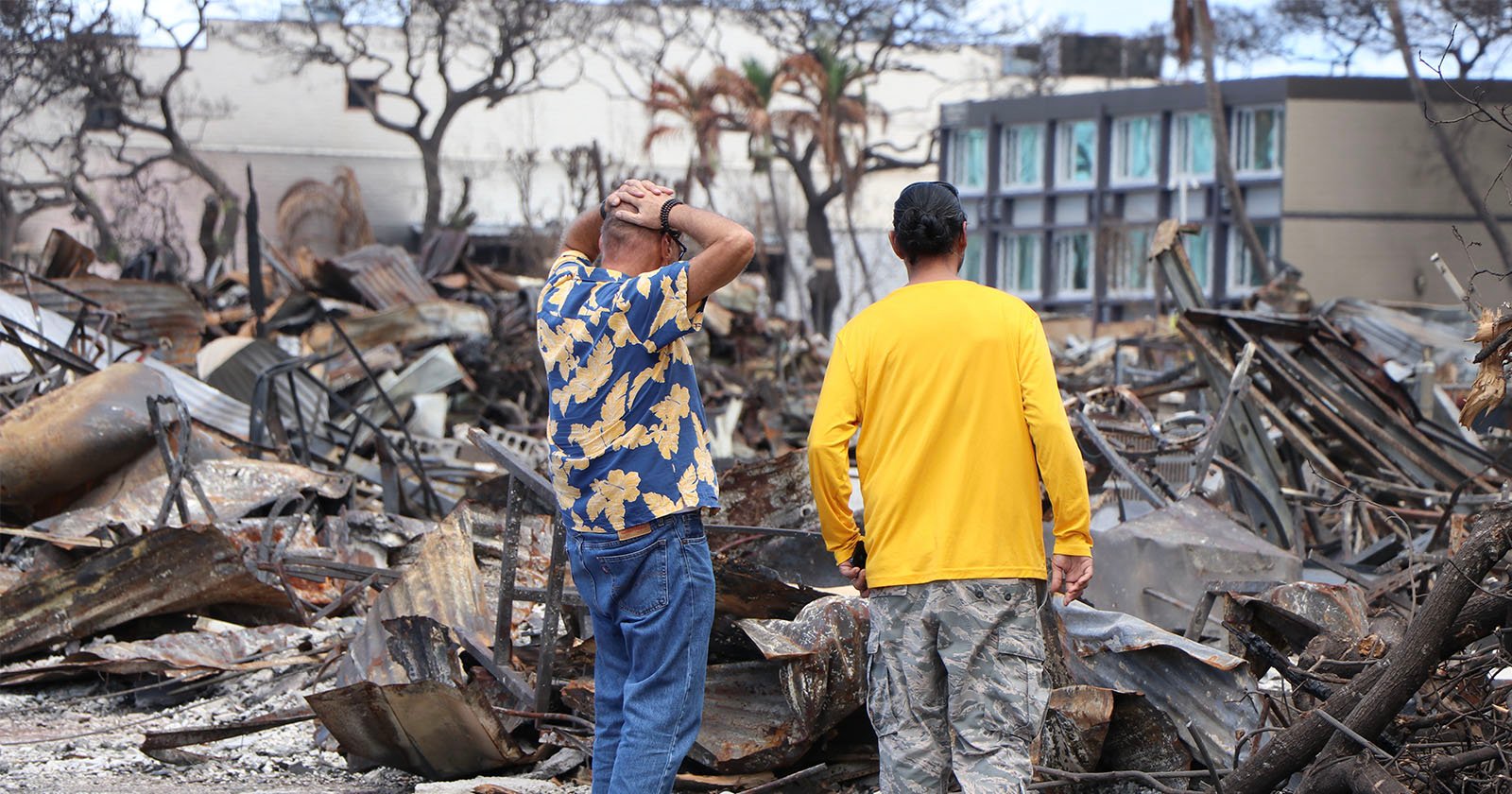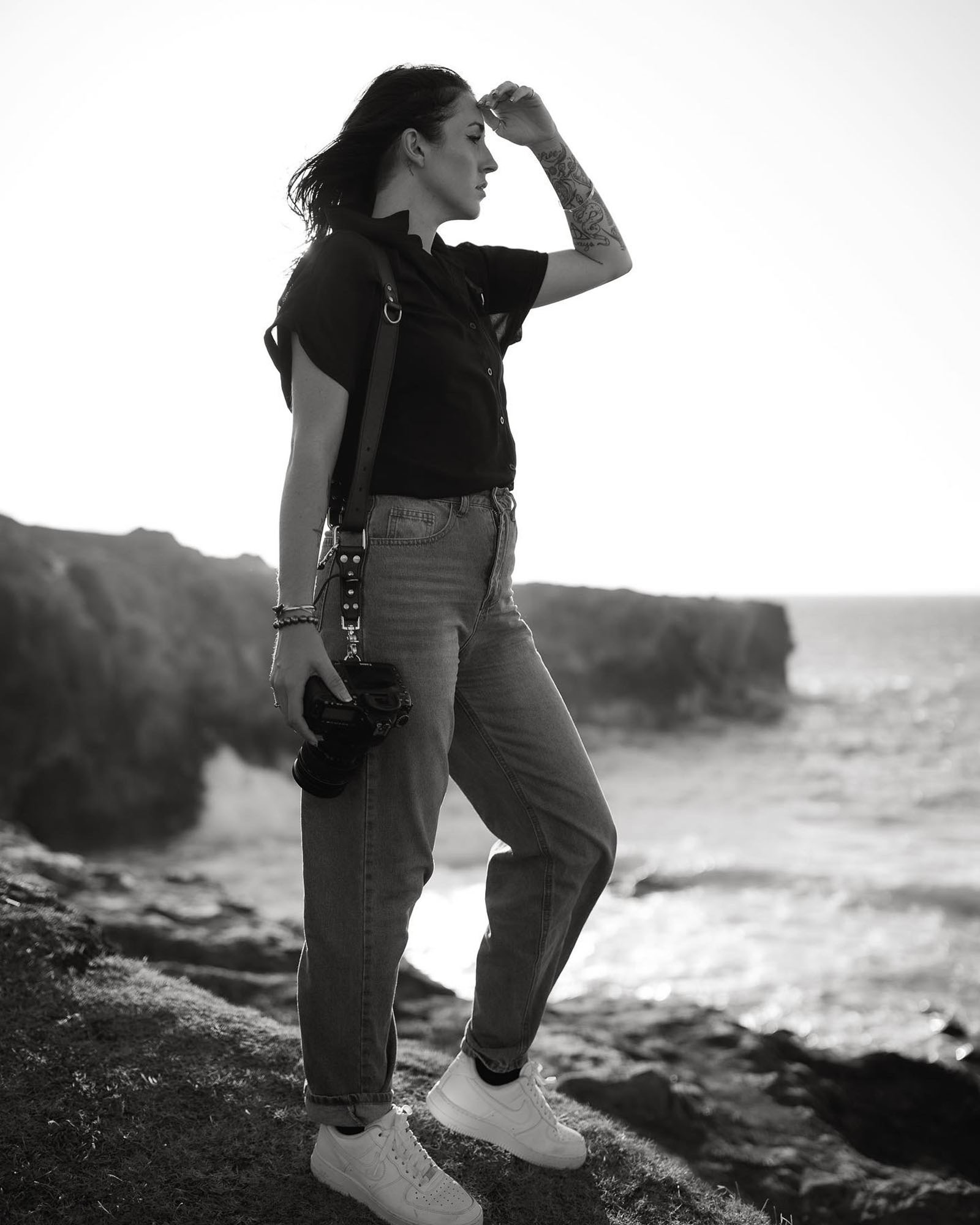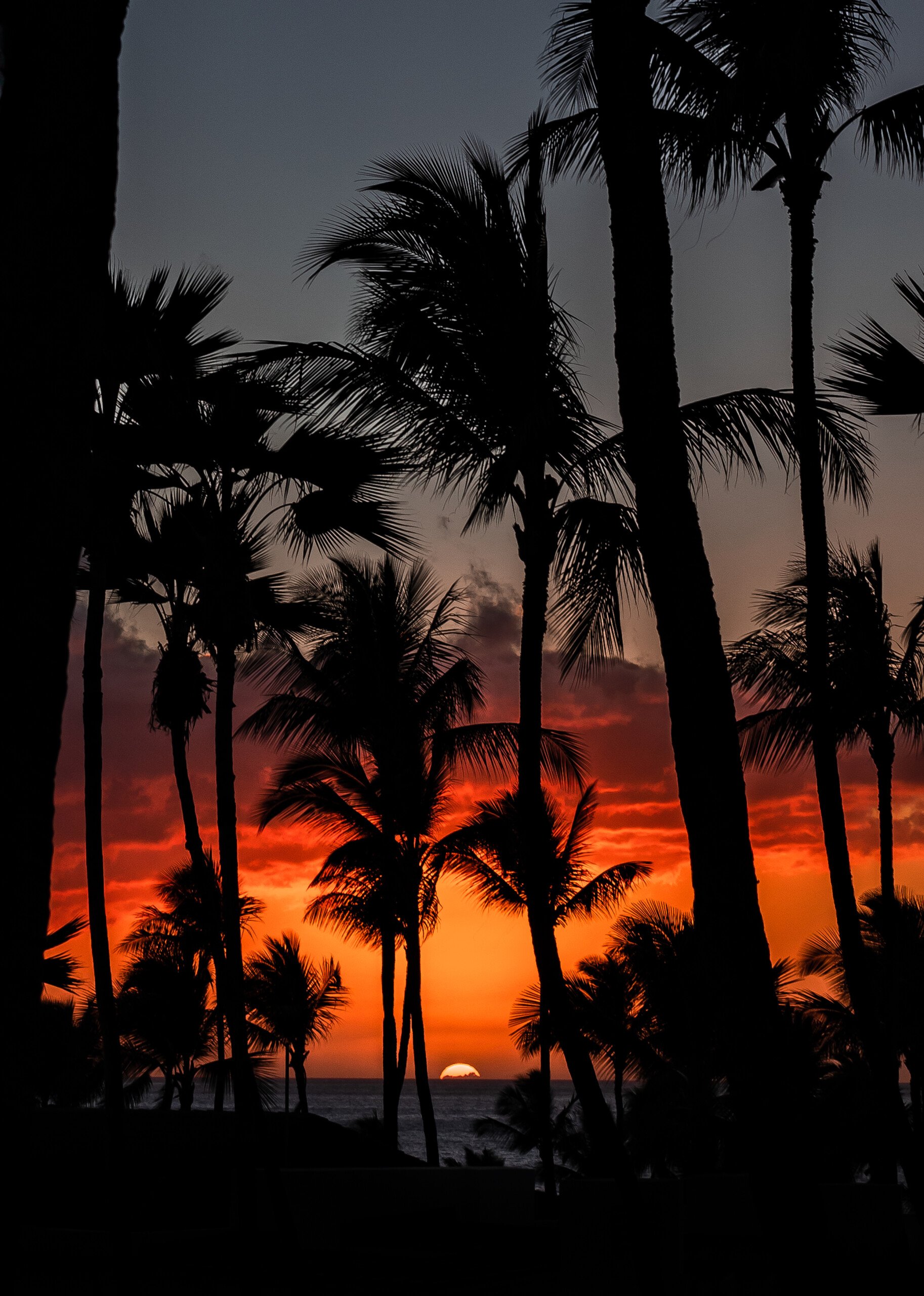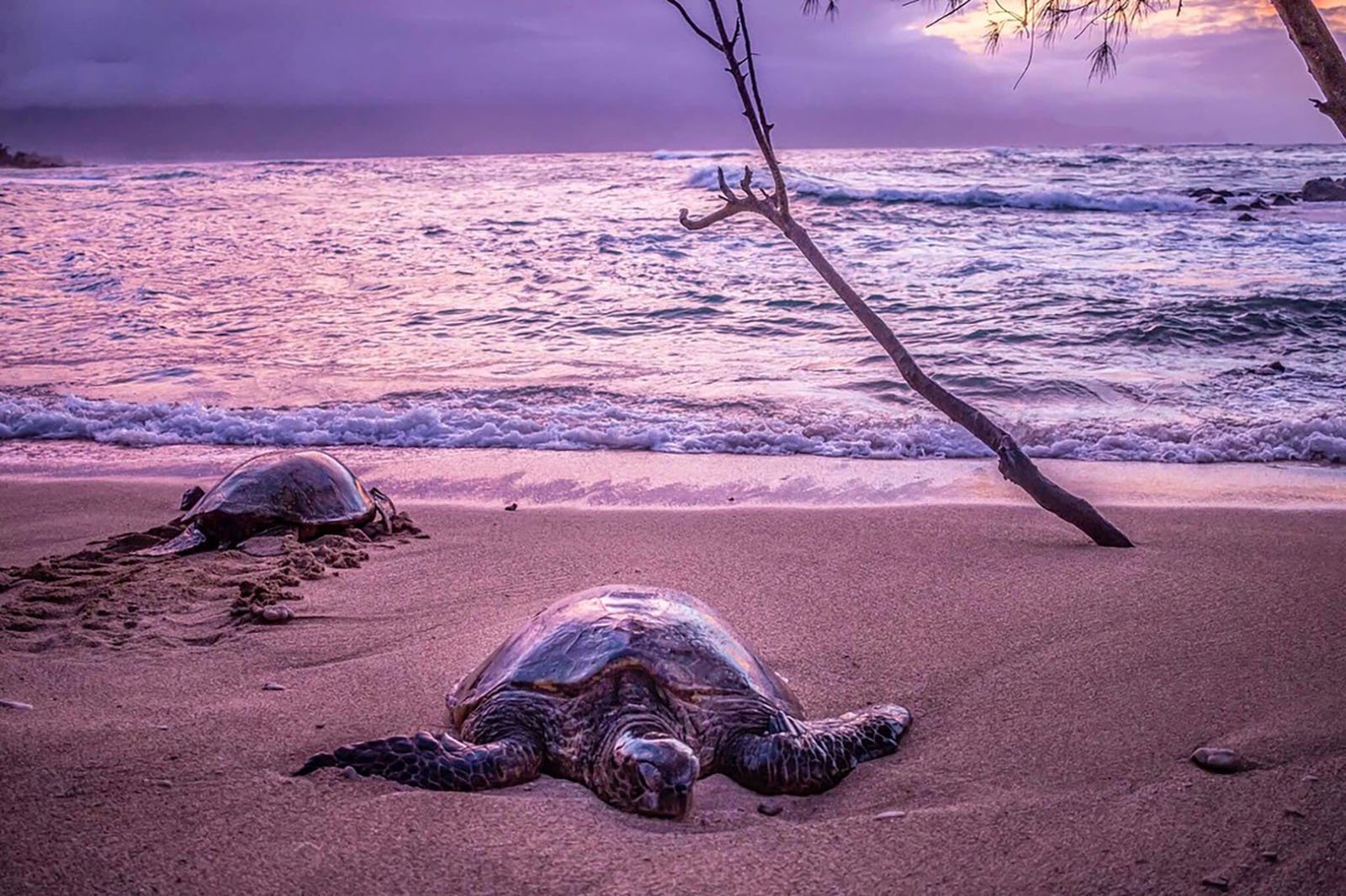In Lahaina, Photographers Look to the Future After Devastating Fires

Rachael Zimmerman, a photographer in Lahaina, Hawaii, woke in the early morning hours the day the fires hit, awakened by the noise from the high winds. In a groggy haze, she fixes the screen windows flying off her condo, but when she looks out the window, she can see some flames in the distance. Zimmerman calls 911, who tells her a transformer power line blew, but that the fire is being put out. She goes back to bed.
When she wakes up again, the power is out, as it would be for the rest of the day. The wind kicks up more, but she can’t close her windows all the way due to the stifling heat and no power to run the AC or fans. Eventually, she smells smoke.
Zimmerman and her partner begin packing up whatever items they can. She grabs some of her camera equipment, though not all of it, a journal, some hard drives, and a bike that belonged to her mother and has been around the world, as she tries to remember what to bring in a rush.
Once in the car is loaded, they leave with their dog, only to be met with gridlock. On the road, Zimmerman realizes it’s not just the fire to the north that she saw earlier burning. There’s a blazing coming from the east as well.

“It was super scary, like I was crying. I didn’t know what was going to happen,” Zimmerman tells PetaPixel.
Eventually, they make their way south and unsuccessfully try to reach friends and loved ones.
“I tried to call like every friend that I have in Lahaina like, like 10 times I called probably, you know, 25 people and no one answered, which was so scary,” she says. Ten minutes later, they had to pick up and keep moving from the fires again.
After eventually making it out of the immediate danger, though, Zimmerman wonders what’s next.

Zimmerman is one of many in Lahaina who are struggling to find a way forward after wildfires ripped through their homes. She tells PetaPixel she doesn’t have a home to return to. On top of that, she and many other photographers are left wondering how they can salvage their business, which is entwined with tourism in the area.
“I feel really defeated and having to restart a business that I’ve worked so hard for,” Zimmerman says. “And then [it’s] just taken from me for no reason.”
Beyond the material losses, Zimmerman has spent the weeks since tracking down her loved ones, and though she says her close circle is accounted for, she knows others in her community who didn’t make it.
Brittney Baker, a photographer in Paia, along the northern coast of Maui, where she was born and raised, echoes a similar experience.

“Every single person that lives on Maui either has lost someone or knows someone that was lost,” Baker tells PetaPixel. She also knows people know were able to make it out of the fires, but were left with nothing but the clothes on their backs.
The death toll, as of the time of this writing, stands at 97 people, with 22 others still missing.
‘It’s not easy to make it on Maui’

The photography industry on Maui is busy. There are endless hordes of families, couples, or individuals coming for the paradise that Hawaii offers, so much so that it’s caused water shortages linked to overtourism. However, that’s not the case in Maui at the moment, and it likely won’t be for a while. And though there’s plenty of opportunity, there’s just as much competition. Within a five-minute distance, there are 10 other working photographers, Zimmerman points out.
“It’s not easy to make it on Maui,” Zimmerman says. “I think it definitely takes a lot of determination to own your own business there and a lot of work.”
As it stands, Lahaina remains closed as the area continues to recover and as many are still missing, but the rest of Maui is open. It should be noted, however, that Hawaiian tourism, even before the fires, has been controversial. Increasingly, Native Hawaiians and those living in Hawaii are asking tourists not to come as the industry depletes resources for locals and from the island. Both Zimmerman and Baker acknowledge that people in Hawaii have mixed feelings about tourism generally, with that, though, comes the concession that many people’s livelihoods depend on tourism, as well. Baker says about 95 percent of her business is made from clients who are tourists.
That business was nearly completely wiped for the near future following the fires.

“Immediately, within 24 to 48 hours, I’d say me and most of the photographers that I know and work with had about 75 percent of their future gigs over the next couple month canceled,” Baker says. The sudden loss of income has also put photographers in a tricky situation returning deposits.
Zimmerman had a job lined up for October with a surf camp she’s worked with before. Now, that business is housing displaced people, creating a snowball effect of businesses without income on the horizon.

The island of Maui is, now, open for tourists, but the west side, where Lahaina is located, remains closed. It’s a situation Baker describes as a double-edged sword.
“It’s a double-edged sword with that, because this is my home,” Baker says. “On one side, I feel so deeply for everyone affected and everyone lost. And when, you know, when people — when our island is overloaded with tourism, they’re taking resources that we may have needed, you know, toilet paper, water, using the police for things, stuff like that. So it’s nice that it has been a little slower because we’ve definitely needed a little bit of that time to recoup mentally, emotionally, physically.”
But Baker adds that it won’t be possible to help those in need without income from tourists going toward local businesses.
‘I don’t have anywhere to live’

Even before the fires, there are unique struggles that professional and even hobbyist photographers in Hawaii must contend with. Zimmerman explains to PetaPixel that many places won’t directly ship lithium batteries, for example. Local photographers must find workarounds, like getting them on the mainland and keeping them in a carry-on (which is allowed) or searching for a suitable shipping option.
Nearly everything, it seems, is harder to get, more expensive, or both. The same goes for housing. Even in the aftermath of devastating wildfires, Zimmerman says, people are looking to move in all the same.

“People are still moving to Maui,” Baker says. She notes that, even after the fires, she sees people posting on housing pages on Facebook, looking to move because of work or other reasons. I’m on a lot of the Facebook housing sites. She adds that incoming residents puts a further strain on much-needed resources.
And those same photographers who have lived in Lahaina or other areas of Maui for years can’t find affordable housing. The housing situation reflects the same controversy as the question of tourism. A housing crisis has made it nearly impossible for the average resident to afford to buy a home, especially as gentrification becomes an increasing factor.
“I don’t have anywhere to live there. And I can’t afford to pay my mortgage and rent when I don’t have any business anymore,” Zimmerman said.
‘We’re kind of just hanging on for a little bit’

With less work, rising costs, and a competitive field, photographers on Maui are left to forge ahead, however that looks.
“We’re kind of just hanging on for a little bit, seeing what we can do on the side and really just crossing our fingers and hoping that once November and December hits that we’ll get a nice little chunk on the side of the island that we usually work on,” Baker tells PetaPixel.
Zimmerman is working back in Colorado, where she’s from and where she got her start as a photographer, as she can’t afford to pay both a mortgage on her home that no longer stands and rent on a new home. And insurance payments aren’t expected in the near future. She says she’s spent her days since evacuating constantly on the phone trying to sort out her living situation.
“I’m still paying a mortgage for air. I was able to defer it for three months, but at the end of the three months, the lump sum is due,” Zimmerman shares.

Just like Baker, she’s also seen rents go up to what she calls astronomical prices.
“As much as I would like to be on Maui and help our community and mourn our losses there, I will go bankrupt. I don’t have a choice but to stay with my family for now and try to build something here for a while.”
Both Baker and Zimmerman pointed to individual Venmo accounts as the best place to give funds for those affected, photographer or otherwise. An Instagram account, lahaina_ohana_venmo, shares stories and Venmo profiles of those in need. The organizations People’s Fund of Maui and Help Maui Rise also provide direct assistance to those who require help.

Zimmerman points out that, while all help is appreciated, there’s more dignity in being able to pick up basic clothing items rather than having to wear unwanted and used clothes. And some organizations, like the Red Cross, have put up too much red tape to present as viable options. Zimmerman says she was told she cannot receive donations without being in-person at a shelter, but she says the shelters are already overrun.
“I think right now the best help for a lot of people, the best help is monetary donations just because a lot of people, like me, have bills to pay, and without a job, how am I going to pay that,” Zimmerman says, adding that those who have not been able to leave the area also need items like air purifiers and bottled water.
The same photographers struggling to make ends meet and are watching gigs disappear from their calendars have jumped into action, sometimes draining whatever money they could afford from their account to buy basic supplies like water. Baker says mainland clients and companies she’s worked with reached out and donated, allowing her to get supply lists and purchase goods directly for those in need. If someone does plan on visiting in the near future, she personally recommends that people donate supplies in addition to spending money at local businesses and giving back to the community.
“In the week after the fires happened when I was volunteering, I was so [grateful] to hear that with us in the crowd of volunteers were a lot of visitors and a lot of tourists that stopped their family vacation to come, you know, physically donate their time.
Image credits: Photographs by Hawaii Department of Land and Natural Resources and Brittney Baker